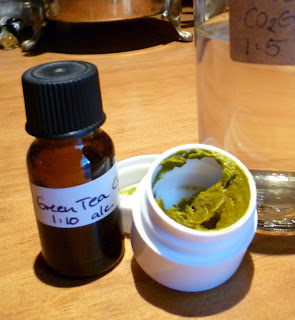BUT (and that's a big but), most of them simply aren't.
There's an ever growing number of pretty sounding concoctions out there in bright shiny bottles with reasuring labels like "organic" and "vegan" plastered all over them, which have as much resemblance to the truly natural bottles of flower extracts and herbs in my workshop as, well, the bottle of commercial toilet cleaner my mother stuck in my cupboard many years ago in the hope I'd eventually use it.
I've spent over 20 years researching and developing natural perfumes. I've studied herbs and aromatherapy oils,and pored over ancient texts full of fascinating ingredients...and spoken to thousands of people at my stalls and on my website about natural perfumery and what it means.
And for years, the conventional perfume industry has belittled what we natural perfumers do, claiming it is archaic, and only modern aromachemicals give you a truely beautiful perfume.
Then all of a sudden, they've discovered that we're on to something! And all over the place, you suddenly see so called "natural" perfumes with bright pretty flower pictures!
A collegue pointed me towards a company I'm not going to name the other day....delightful packaging, pretty sounding scents...and "Beauty Habit", where they are sold, writes the following:
"L### & T## believes that natural formulas should function and not fail. These formulas have been vigorously tested for performance and stability.Each product is loaded with the very best natural and organic ingredients, while delivering a luxurious, skin-nurturing experience." And in the listing for their handcreams, list the scent as "botanical perfume blend".
But hang on a minute, the bottles contain completely clear fluid for starters (And natural perfumes just don't come in clear...)....let's have a look at the ingredients of one of them, ": "Vanilla Orchid, White Musk, Jasmine, Ebony Woods, Natural Alcohol"
OK, for starters, that's not an ingredient list, it's a fanciful list of the notes in the fragrance.
There is no such thing as vanilla orchid, white musk or ebony wood. And wtf is natural alcohol supposed to be? As opposed to un-natural alcohol?
These perfumes aren't natural. Not even nearly natural. Yet the advertising sells them as such, loud and clear.
And it frustrates the hell out of me. Because people believe what they see written. And it seems, you can write whatever you want and get away with it. Loud and clear.
Mmfph.
Did you know that you can call anything vegan if it doesn't have animal ingredients in it? plastic gumboots are vegan by that definition!
And "Natural" can mean just about anything. I did a bit of research into natural flavours some time back, and discovered that a natural flavour can be made entirely of individual chemicals, as long as said chemicals were originally extracted from a natural source!
And mind you, that source doesn't have to have anything to do with the the fruit of vegetable it's imitating!
The Truth Seeker writes: Natural and artificial flavors are now manufactured at the same chemical plants, places that few people would associate with Mother Nature.
To me that seems like cheating. All chemicals are originally extracted from natural sources. It is the degree of processing that takes them from natural to artificial.
Raspberries are natural. raspberry juice is natural. Raspberry ketone is a scent chemical that can be extracted from raspberry juice, or also made by chemical process from other chemicals. It is a white crystaline substance, that can be dissolved in alcohol and used in very diluted form in fruity scents to give the impression of raspberry....
Is it natural? I'm not sure. I have two kinds of raspberry scented ingredients in my workshop:
One, an alcoholic extract of raspberry, which is dark brownie red and slightly sticky, and needs to be filtered before I add it to scents. And the above said raspberry ketone, a strange little bottle of white powdery crystals....the crystals themselves have no scent until disolved further in alcohol.
There are a growing number of companies that are useing natural isolates like raspberry ketone in their perfumes too. I'm not sure how I feel about this. Like many botanical perfumers, I crave some notes that simply aren't available on the market....there are no natural violet extracts, and some fruit notes like "dewberry" simply don't exist in natural form.
And it is a very tempting idea to follow along the "Natural Flavour" lines and start recreating these scent notes useing individual chemicals extracted from natural sources. But I feel uneasy about it.
The biggest question for me is where do we stop? When does a perfume go from being a real natural product crafted from exquisite absolutes and essential oils, to being, in reality, merely an artificially created scent concoction made purely from ingredients cooked up in a science lab like all of the others out there....
I'm not sure what the answer is. I'm experimenting with isolates, and keeping an open mind...but it does leave me feeling uneasy.
I feel somewhat guilty, as if I were experiementing with illegal drugs.....
I do know one thing for sure: If I do end up useing natural isolates in any of my perfumes, I will be honest and open about this.


